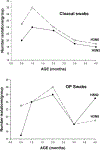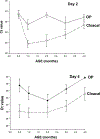The effect of age on avian influenza viral shedding in mallards (Anas platyrhynchos)
- PMID: 20521698
- PMCID: PMC11337148
- DOI: 10.1637/8692-031309-ResNote.1
The effect of age on avian influenza viral shedding in mallards (Anas platyrhynchos)
Abstract
Avian influenza virus (AIV) prevalence in wild aquatic bird populations varies with season, geographic location, host species, and age. It is not clear how age at infection affects the extent of viral shedding. To better understand the influence of age at infection on viral shedding of wild bird-origin low pathogenicity avian influenza (LPAI) viruses, mallards (Anas platyrhynchos) of increasing age (2 wk, 1 mo, 2 mo, 3 mo, and 4 mo) were experimentally inoculated via choanal cleft with a 10(6) median embryo infectious dose (EID50) of either A/Mallard/MN/355779/00 (H5N2) or A/Mallard/MN/199106/99 (H3N8). Exposed birds in all five age groups were infected by both AIV isolates and excreted virus via the oropharynx and cloaca. The 1-month and older groups consistently shed virus from 1 to 4 d post inoculation (dpi), whereas, viral shedding was delayed by 1 d in the 2-wk-old group. Past 4 dpi, viral shedding in all groups varied between individual birds, but virus was isolated from some birds in each group up to 21 dpi when the trial was terminated. The 1-mo-old group had the most productive shedding with a higher number of cloacal swabs that tested positive for virus over the study period and lower cycle threshold values on real-time reverse-transcription PCR. The viral shedding pattern observed in this study suggests that, although mallards from different age groups can become infected and shed LPAI viruses, age at time of infection might have an effect on the extent of viral shedding and thereby impact transmission of LPAI viruses within the wild bird reservoir system. This information may help us better understand the natural history of these viruses, interpret field and experimental data, and plan future experimental trials.
Nota de Investigación—Efecto de la edad en la diseminación del virus de influenza aviar en patos de collar (Anas platyrhychos).
La prevalencia del virus de influenza aviar en poblaciones de aves silvestres acuáticas varía de acuerdo con la estación, con la locación geográfica, la especie hospedadora y con la edad. No esta definido como la edad afecta el nivel de diseminación viral. Para entender mejor la influencia de la edad en el momento de infección sobre la diseminación del virus de la influenza aviar de baja patogenicidad provenientes de aves silvestres, se inocularon experimentalmente patos de diferentes edades (dos semanas, un mes, tres y cuatro meses) por vía de la hendidura palatina con 106 dosis infecciosas 50% en embrión (EID50) de un virus denominado A/pato de collar/MN/355779/00 (H5N2) o con otro denominado A/pato de collar/MN/199106/99 (H3N8). Aves de los cinco grupos de edad se infectaron con ambos aislados del virus de influenza aviar y mostraron excreción del virus por vía de la orofaringe y por la cloaca. Las aves de un mes y de mayor edad diseminaron virus de manera consistente desde el día uno al día 4 post inoculación, mientras que en el grupo de dos semanas de edad la diseminación se retardo un día. Después del día cuatro después de la inoculación, la diseminación en todos los grupos presentó variaciones entre individuos, pero el virus fue aislado de algunas aves en cada grupo hasta los 21 días post infección cuando se terminó el experimento. El grupo de aves de un mes de edad mostró la mayor diseminación con mayor número de hisopos cloacales positivos para el virus durante el periodo del estudio y con los valores de ciclos umbrales más bajos por la prueba de transcripción reversa y reacción en cadena de la polimerasa en tiempo real. El patrón de diseminación observado en este estudio sugiere que aun cuando patos de diferente grupos de edad pueden infectarse y diseminar el virus de influenza aviar de baja patogenicidad, la edad en el momento de la infección puede tener un efecto en los niveles de diseminación viral y por consecuencia un impacto en la transmisión de estos virus dentro del sistema de reservorios en las aves silvestres. Esta información puede ser útil para el mejor conocimiento de la historia natural de estos virus, la interpretación de datos experimentales y para la planificación de futuros experimentos.
Figures


Similar articles
-
Variation in viral shedding patterns between different wild bird species infected experimentally with low-pathogenicity avian influenza viruses that originated from wild birds.Avian Pathol. 2011 Apr;40(2):119-24. doi: 10.1080/03079457.2010.540002. Avian Pathol. 2011. PMID: 21500030
-
Intestinal excretion of a wild bird-origin H3N8 low pathogenic avian influenza virus in mallards (Anas Platyrhynchos).J Wildl Dis. 2012 Oct;48(4):991-8. doi: 10.7589/2011-09-280. J Wildl Dis. 2012. PMID: 23060500 Free PMC article.
-
Effect of different routes of inoculation on infectivity and viral shedding of LPAI viruses in mallards.Avian Dis. 2012 Dec;56(4 Suppl):981-5. doi: 10.1637/10151-040812-ResNote.1. Avian Dis. 2012. PMID: 23402123
-
Effect of a prior exposure to a low pathogenic avian influenza virus in the outcome of a heterosubtypic low pathogenic avian influenza infection in mallards (Anas platyrhynchos).Avian Dis. 2010 Dec;54(4):1286-91. doi: 10.1637/9480-072210-Reg.1. Avian Dis. 2010. PMID: 21313851 Free PMC article.
-
Differential Viral Fitness Between H1N1 and H3N8 Avian Influenza Viruses Isolated from Mallards (Anas platyrhynchos).Avian Dis. 2015 Dec;59(4):498-507. doi: 10.1637/11074-033015-Reg. Avian Dis. 2015. PMID: 26629623
Cited by
-
Impact of body condition on influenza A virus infection dynamics in mallards following a secondary exposure.PLoS One. 2017 Apr 19;12(4):e0175757. doi: 10.1371/journal.pone.0175757. eCollection 2017. PLoS One. 2017. PMID: 28423047 Free PMC article.
-
Competition between influenza A virus subtypes through heterosubtypic immunity modulates re-infection and antibody dynamics in the mallard duck.PLoS Pathog. 2017 Jun 22;13(6):e1006419. doi: 10.1371/journal.ppat.1006419. eCollection 2017 Jun. PLoS Pathog. 2017. PMID: 28640898 Free PMC article.
-
Reassortant influenza A viruses in wild duck populations: effects on viral shedding and persistence in water.Proc Biol Sci. 2012 Oct 7;279(1744):3967-75. doi: 10.1098/rspb.2012.1271. Epub 2012 Aug 1. Proc Biol Sci. 2012. PMID: 22859590 Free PMC article.
-
Virus Shedding of Avian Influenza in Poultry: A Systematic Review and Meta-Analysis.Viruses. 2019 Sep 2;11(9):812. doi: 10.3390/v11090812. Viruses. 2019. PMID: 31480744 Free PMC article.
-
Juveniles and migrants as drivers for seasonal epizootics of avian influenza virus.J Anim Ecol. 2014 Jan;83(1):266-75. doi: 10.1111/1365-2656.12131. Epub 2013 Sep 4. J Anim Ecol. 2014. PMID: 24033258 Free PMC article.
References
-
- Brown JD, Stallknecht DE, Berghaus RD, Luttrell MP, Velek K, Kistler W, Costa T, Yabsley MJ, and Swayne D. Evaluation of a commercial blocking ELISA as a serologic assay for detecting avian influenza virus infection in multiple experimentally infected avian species. Clin. Vaccine Immunol 16:824–829. 2009. - PMC - PubMed
-
- Deibel R, Emord DE, Dukelow W, Hinshaw VS, and Wood JM. Influenza viruses and paramyxoviruses in ducks in the Atlantic flyway, 1977–1983, including an H5N2 isolate related to the virulent chicken virus. Avian Dis. 29:970–985. 1985. - PubMed
-
- Jilbert AR, Botten JA, Miller DS, Bertram EM, Hall PM, Kotlarski J, and Burrell CJ. Characterization of age- and dose-related outcomes of duck hepatitis B virus infection. Virology 244:273–282. 1998. - PubMed
Publication types
MeSH terms
Grants and funding
LinkOut - more resources
Full Text Sources
Medical
Miscellaneous

